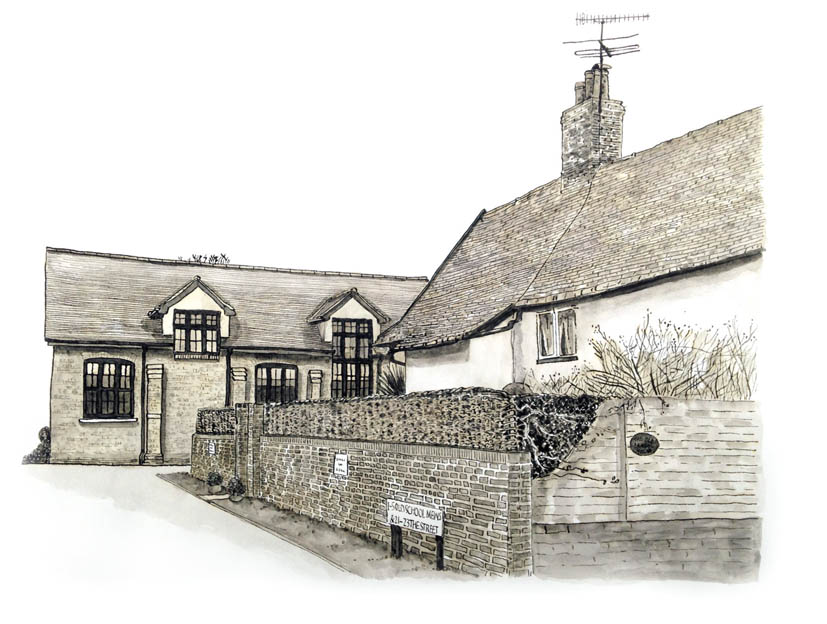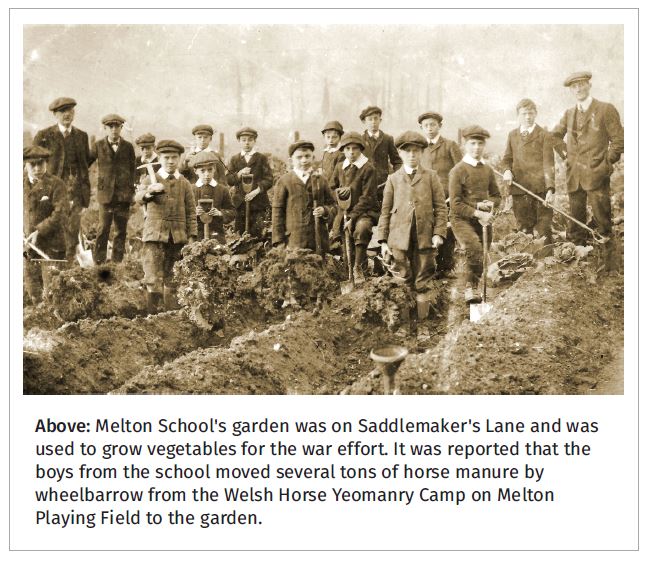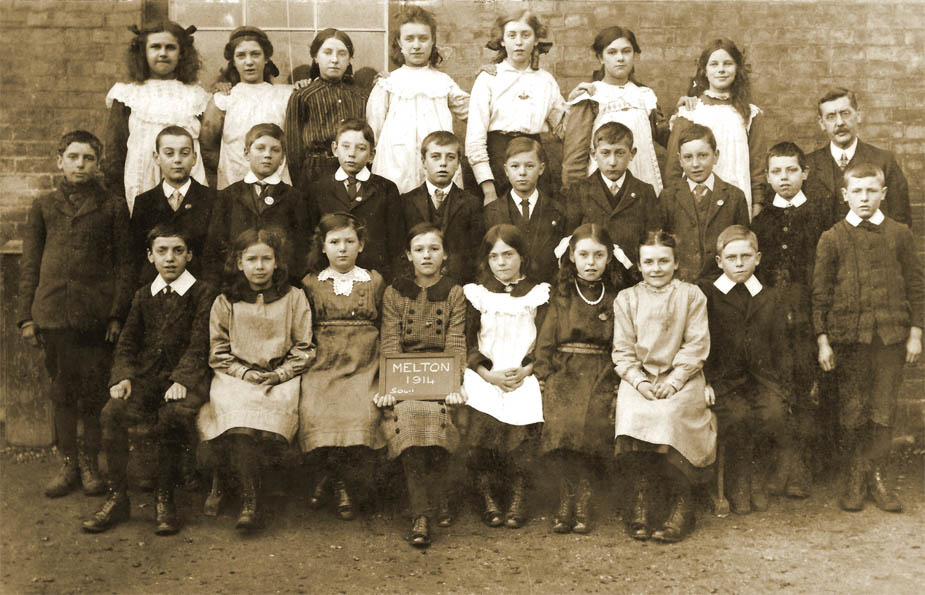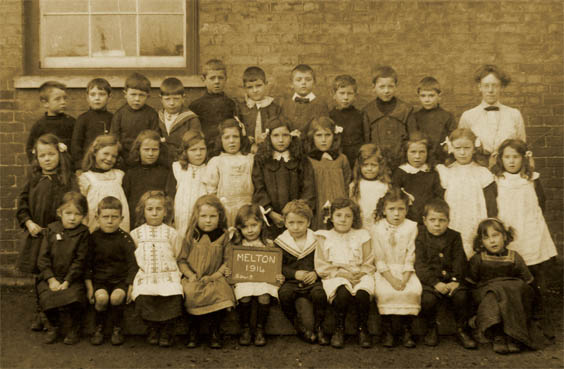The Old School House and Melton Road School.
ILLUSTRATION: JENNIFER HALL. OAK GALL INK ON PAPER. 2019.
A national school to provide education for village children was first established in The Street around 1845 where the school premises, enlarged firstly in 1885 and then again in 1894, remained until its move to a new building in Melton Road during 1964.
By 1914, the school was well established under the control of the East Suffolk Local Education Authority; it was governed at local level by a Board of Managers. Around one hundred and fifty boys and girls were on the register. At that time, it was compulsory for children to attend school between the ages of five and thirteen, when many hard-pressed families were undoubtedly keen for their offspring to begin work and contribute to the household budget. (Following publication of The Fisher Act in 1918, the school leaving age was raised to 14).
The majority of village children completed the whole of their education at the Elementary School and a number of pupils who met the standard, mostly boys, were offered the opportunity to continue their studies via Foundation Scholarships at the Grammar School (now Woodbridge School), Mills Grammar School for Girls, Framlingham College, Ipswich High School and Leiston Grammar School.
Typically, classes in elementary schools at this time were large, with a qualified teacher in charge, supported by a pupil-teacher or unqualified assistant teachers. The position of pupil-teacher was often conferred on older, more able pupils. Teacher training at that time was a two-year course and many students would have previously gained experience as pupil-teachers.
The curriculum offered to elementary pupils at this period centred on the core subjects of Reading, Writing and Arithmetic. Other areas of learning offered at Melton included History, Geography, Drawing, Hygiene, Patriotism and the Promotion of Empire, Physical Education or Drill, Gardening (boys), Laundry (girls), Needlework (girls), Cookery (girls), Singing, Poetry and Nature Study. Permission from East Suffolk Education Committee for the teaching of Scripture had been granted to the Rector. Some headteachers chose to explain local and world affairs to pupils. The school had use of a harmonium to support music lessons. Throughout the war, all Suffolk council schools were provided with a short prayer to use on behalf of "soldiers, sailors, wounded and bereaved".

As the war progressed and more men from agricultural and food growing industries left to take up arms, pressure mounted on schools to release older pupils to work on the land and help keep the nation fed. In March 1915, the Woodbridge and District War Relief Committee submitted a request to the Education Committee for the bye-laws relating to school attendance to be relaxed for the duration of the war, allowing children to leave school at the age of twelve providing suitable employment could be found for them. This resulted in a hotly charged debate. It was eventually agreed that boys over the age of twelve could be temporarily released for work from April until the end of August, providing employers met satisfactory conditions in terms of welfare and wages. Parents were required to give written undertaking that their children would be back in school by September.
Contemporary newspaper reports suggest that school children were actively involved in gathering resources to help the war effort e.g. blackberries for jam and eggs donated to the Red Cross hospital. Horse chestnuts were gathered for the production of acetone, a key component of cordite used as the propellant for bullets and shells. Acorns were collected and used unsuccessfully as fuel or more successfully, according to schoolboy Bob Daines (Robert William Daines b1907 Melton), to feed the pigs belonging to Charles Brasnett of Melton House on The Street. Children from local schools knitted scarves, mittens, socks, cuffs, pillow cases and vests, as well as blackboard dusters. Money for the purchase of wool was raised by mending and selling unwanted items. The Girl’s Friendly Society, an organisation set up in 1875 to help young girls in service who were living away from their families, encouraged their members to sew hospital bags. These were sent to military hospitals in Britain and abroad and were used to keep the personal possessions of wounded soldiers together while they were being treated. The local organiser was Miss Emma Cadmore of Ufford who brought the girls together to make the bags for Lady Smith-Dorrien’s Hospital Bag fund.
The Government heavily promoted the saving of money through schemes such as the Penny Bank and the War Savings Association run by schools. The “Overseas Club” was created to encourage children to donate to a fund to send “some comfort and happiness to the brave sailors and soldiers of the British Empire, fighting to uphold liberty, justice, honour and freedom in the Great War”. In return, the children were sent an individual certificate to acknowledge their help. The Woodbridge Reporter and Wickham Market Gazette reported on 13th December 1917 that:
“The little ones attending the national Infant’s school in Woodbridge have again done their “little bit” by sending 10 shillings to the “Overseas Club” for cigarettes and tobacco to be sent to our brave men fighting for our King and Country.”
The School’s Board of Managers was made up from members of the local community, much like school governors today. During the war years, members of the board included: James Burness, Chairman, of Melton Lodge; Mrs Enid Sulivan of Fern Hill; William H Bradley, an agricultural implement maker living at Foundry House; and E Smith of The Melton Coal & Corn Company.
In 1917, the newly-appointed Rector of Melton, John Herbert Orpen, joined the board and, in 1919, Arthur Turnour Murray of the Red Towers replaced James Burness following his retirement due to ill health.
The day-to-day running of the school was the responsibility of head teacher, Richard Bentham. He had been appointed in 1893 and remained in his post until his retirement in 1924. During the war years, Richard was assisted by a combination of certificated and uncertificated teaching staff. In addition, temporary teachers were employed to cover staff absent on military service.
In addition to Richard Bentham, the following people have been identified as working at the school during the war. Their biographies can be found by clicking on their names: Ethel Donald, Maud Amer and William Belton
Four other people are named in the school manager’s minutes as teaching at Melton School: Mrs Dibble and Miss Lait, about whom there is no further information. The other two were Richard Bentham’s daughters Margaret Ida and Dorothy who were permitted by Leiston Grammar School to help their father whenever there was a shortage of teachers due to the war.
The board minutes also recorded some of the effects of the war upon the school; in the early days, the building was used for an army recruitment meeting and later, when there were troops billeted in the village, Richard Bentham asked the Education Committee to allow the soldiers to use the school in the evenings. He agreed to personally fund the cost of gas, "firing", cleaning and the repair of any damage. The school was closed to pupils in November 1914 and deployed as a clothing distribution depot by the military. It was at this time that the Essex Yeomanry who had been billeted in Melton and Ufford was posted to France.
In 1915, a weekly Sunday School was held in two of the school rooms from 14.30 until 15:20 in the afternoon. From September that year, the school day was shortened during the winter months due to the lack of fuel for the heating and the blackout imposed after the Zeppelin raid on 12th August 1915. School closures due to the lack of fuel for heating, staff absences and illness continued through the remaining war years.
In 1916, after an outbreak of whooping cough, the school closed while it was disinfected. Measles was also brought in by troops passing through the local villages and local schools were forced to close due to the number of pupils affected.
Over the winter of 1918 to 1919, an epidemic of influenza shut the school from 6th November to 12th December 1918 and 13th February to 3rd March 1919.
Senior pupils of Melton School in 1914 with the headmaster Richard Bentham. Junior pupils of Melton School with their teacher who is believed to be Ethel Donald.

